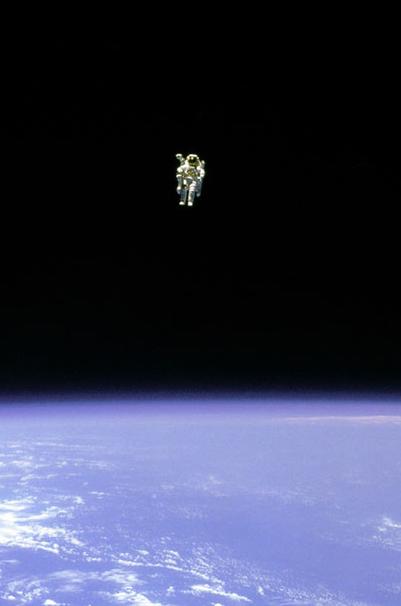How is he ever going to make it back to his spaceship?
His situation seems hopeless. However, he remembers the lessons he received as rookie astronaut on swimming in empty space. By applying a weird degenerative form of breaststroke the astronaut slowly moves toward the spaceship and makes it safely back before he runs out of oxygen.

What to think of this? Repetitive flexing of his muscles causing an astronaut to move through empty space? Swimming without pushing against anything or being pushed by anything? Sounds unbelievable? Literal bootstrapping in a mediocre science fiction scenario? Surely since Newton we know that neither Baron Von Munchausen nor anyone else can pull himself up by his own bootstraps!
Well, think again. MIT professor Jack Wisdom did demonstrate in a paper published in 2003 in Science that it is possible to translate a deformable body solely by applying internal forces.
So you ask: if that is so, why can't we lift ourselves up and breaststroke through the sky? Well, the issue is that professor Wisdom's 'breaststroke' is not particularly effective to overcome earth's gravity, as it relies on the local curvature of spacetime. This curvature is very small, and its effects are hardly noticable in everyday life and over small distances. Yet, since Einstein we know that spacetime is curved due to the presence of mass in the universe.
Distant stars and planets bend spacetime and create a non-Euclidean geometry. Would one measure the sum of the angles of a giant triangle formed in space, these angles would not add up to 180 degress as Euclidean geometry stipulates. It is precisely this deviation from the flat Euclidean geometry that enables swimming through a vacuum.
So how does it work?
It is easy to see that in the case of a universe that is curved back onto itself, one can apply an extreme form of spacetime swimming by applying a giant 'crawl' embracing the whole universe. This can be achieved simply by repetitively throwing away an object and catching this object again as it returns from the reverse direction once it has completed its trip through the universe. Referring to this repetitive process as 'swimming' seems cheeting.
Yet the classification 'swimming' is appropriate once one accepts that 'swimstrokes' can be identified for disconnected systems such as – in this case – the system of thrower plus object. Obviously, the result of each stroke is that this system start and end in the same situation (with the thrower holding the object in his hands), whilst having moved through space due to the backreaction exerted by the throwing of the object.
As Wisdom demonstrated, in a curved universe less extreme swimming strokes can be defined that do not encompass the whole universe, but that consist of moves within a local region of space. These are true strokes without involving cheats such as disconnected objects. The Scientific American paper describes a simple analogy to our astronaut swimmer in four dimensional spacetime that involves fewer dimensions and can easily be visualized. Imagine a two-dimensional three-legged creature moving frictionlessly over the surface of a sphere.
Let's say this creature is positioned at the equator with one leg pointing east and two legs pointing along the lines of longitude towards the north and south poles. The swim stroke consists of four moves. First the tripodal creature extends its two longitudinal legs, and subsequently it extends the eastern leg. To complete the stroke, it retracts the longitudinal legs and finaly retracts the eastern leg. As a result of each such 'swimstroke' the creature moves a wee bit westward.
Why is this?
Key is that when the eastern leg extends, the longitudinal legs are extended away from the equator, whilst when the eastern leg retracts, the they are closer to the equator. If the creature keeps its longitudinal legs all the time oriented along the sphere's lines of longitude, the backreaction to the eastern leg extending translates into a smaller movement at the tip of the longitudinal legs, and a larger movement at the base of the longitudinal legs located at the equator.
The reverse is true for the backreaction to the eastern leg retracting. As a result, the westward movement of the base of the longitudinal legs along the equator is larger than its eastward movement.
A video of the movements will makes all of this hopefully clearer: http://www.iop.org/EJ/mmedia/1367-2630/8/5/068/movie1.avi
As elaborated in the Scientific American article, key to this swimming in empty space is the fact that the concept of center-of-mass is ill-defined in non-Euclidean space. Non-Euclidean space swimming is geometric in nature and entirely determined by the sequence of shapes assumed. In several ways this swimming is similar to the mechanism by which a cat falling upside-down rotates itself during free fall. Physicists refer to geometric phases to describe these effects.
Einstein's theory on spacetime curvature is now almost a century old. Only since a few years are we aware that his theory allows for spacetime swimming. The fact that this possibility remained unnoticed for such a long period makes us realize that we are still wrestling to understand all the consequences of Einstein's rich theories, and that we better be ready for a few more surprises at the horizon.




Comments